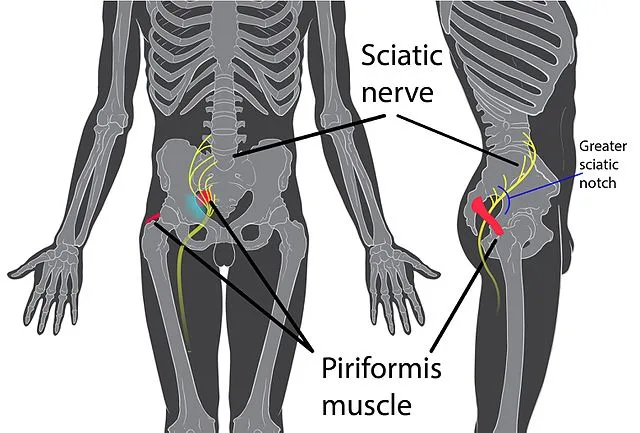Alleviating Pain and Restoring Mobility
Subtitle: Discover Effective Yoga Techniques to Relieve Piriformis Syndrome
Introduction
Piriformis syndrome is a common and debilitating condition that affects many individuals, causing pain and discomfort in the buttocks and lower back. This condition occurs when the piriformis muscle, located deep within the gluteal region, becomes tight or inflamed, leading to compression of the sciatic nerve. While medical intervention and physical therapy are often recommended, integrating specific yoga practices into your routine can provide significant relief and aid in the healing process. In this article, we will explore the benefits of yoga for piriformis syndrome and discuss effective techniques to alleviate pain and restore mobility.
Understanding Piriformis Syndrome
Before delving into the potential of yoga for treating piriformis syndrome, it’s essential to understand the condition itself. The piriformis muscle plays a crucial role in hip rotation and stabilization. When this muscle becomes overly tight or experiences inflammation, it can irritate the nearby sciatic nerve, leading to symptoms such as pain, numbness, and tingling along the buttocks and down the leg. Piriformis syndrome can be caused by factors like prolonged sitting, overuse, muscle imbalances, or direct trauma to the buttocks.
Is it OK to Do Yoga with Piriformis Syndrome?
Many individuals with piriformis syndrome wonder if practicing yoga is safe and beneficial. The answer is, in most cases, yes! However, it is important to approach yoga mindfully and modify certain poses to suit your condition. Yoga can help improve flexibility, strengthen supportive muscles, and enhance overall body awareness. Engaging in gentle stretches and targeted poses can release tension in the piriformis muscle, thereby alleviating compression on the sciatic nerve.
How to Heal Piriformis Syndrome with Yoga
1. Gentle Supine Twist (Supta Matsyendrasana)
Lie on your back with knees bent and feet flat on the ground. Cross the right ankle over the left knee, forming a figure four shape. Slowly lower both knees to the left side while keeping your upper back and shoulders grounded. Hold the stretch for 30 seconds to one minute, breathing deeply. Repeat on the other side. This pose helps stretch and release tension in the piriformis muscle.
2. Pigeon Pose (Eka Pada Rajakapotasana)
Start in a high plank position and bring your right knee forward, placing it behind the right wrist. Slide the left leg back, ensuring it is straight and extended. Slowly lower your upper body to the ground, resting on your forearms or a bolster for support. Hold the pose for 1-2 minutes, focusing on deep breathing. Repeat with the other leg. Pigeon pose is excellent for stretching and relaxing the piriformis muscle.
3. Reclining Hand-to-Big-Toe Pose (Supta Padangusthasana)
Lie on your back and bring your right knee towards your chest. Place a strap or yoga belt around the ball of your right foot and extend the leg upward, keeping it straight. Hold the strap with both hands and gently pull the leg toward your head until you feel a stretch in the hamstring and buttock. Hold for 30 seconds to one minute and repeat on the other side. This pose helps relieve tension in the piriformis muscle and promotes flexibility.
4. Child’s Pose (Balasana)
Kneel on the ground and sit back on your heels. Slowly lower your upper body forward, reaching your arms out in front of you. Rest your forehead on the mat or a cushion. Stay in this pose for 1-2 minutes, focusing on deep breathing and allowing your glutes and lower back to relax. Child’s pose provides a gentle stretch to the buttocks and can help alleviate discomfort associated with piriformis syndrome.
5. Bridge Pose (Setu Bandhasana)
Lie on your back with knees bent and feet flat on the ground, hip-width apart. Press your feet into the mat, engage your glutes, and lift your hips off the ground. Interlace your hands beneath your pelvis and gently roll your shoulders underneath you. Hold the pose for 30 seconds to one minute, breathing deeply. Bridge pose helps strengthen the gluteal muscles and promote better alignment in the lower back.
FAQs: Frequently Asked Questions
Is it OK to do yoga with piriformis syndrome?
Yes, it is generally safe to practice yoga with piriformis syndrome. However, it is crucial to listen to your body, avoid pain, and modify poses as needed.
How to heal piriformis syndrome with yoga?
Yoga can help heal piriformis syndrome by releasing tension in the piriformis muscle, strengthening supportive muscles, and improving flexibility. Specific poses like Supine Twist, Pigeon Pose, and Reclining Hand-to-Big-Toe Pose can be beneficial.
How I healed my piriformis syndrome?
While personal experiences may vary, some individuals have found relief from piriformis syndrome by incorporating yoga, physical therapy, and lifestyle modifications into their routine. It’s essential to work with a healthcare professional to develop a tailored treatment plan.
Is it OK to exercise with piriformis syndrome?
Engaging in low-impact exercises that do not exacerbate pain or put excessive strain on the affected area can be beneficial. Consult with a healthcare professional or physical therapist to determine suitable exercises for your condition.
Conclusion
Piriformis syndrome can significantly impact your daily life, but integrating yoga into your routine can provide relief and aid in the healing process. By practicing specific poses like Gentle Supine Twist, Pigeon Pose, Reclining Hand-to-Big-Toe Pose, Child’s Pose, and Bridge Pose, you can effectively stretch and release tension in the piriformis muscle, alleviate compression on the sciatic nerve, and restore mobility. Remember to listen to your body, make modifications as needed, and consult with a healthcare professional for a comprehensive treatment plan. Embrace the transformative power of yoga and regain control over your well-being!
